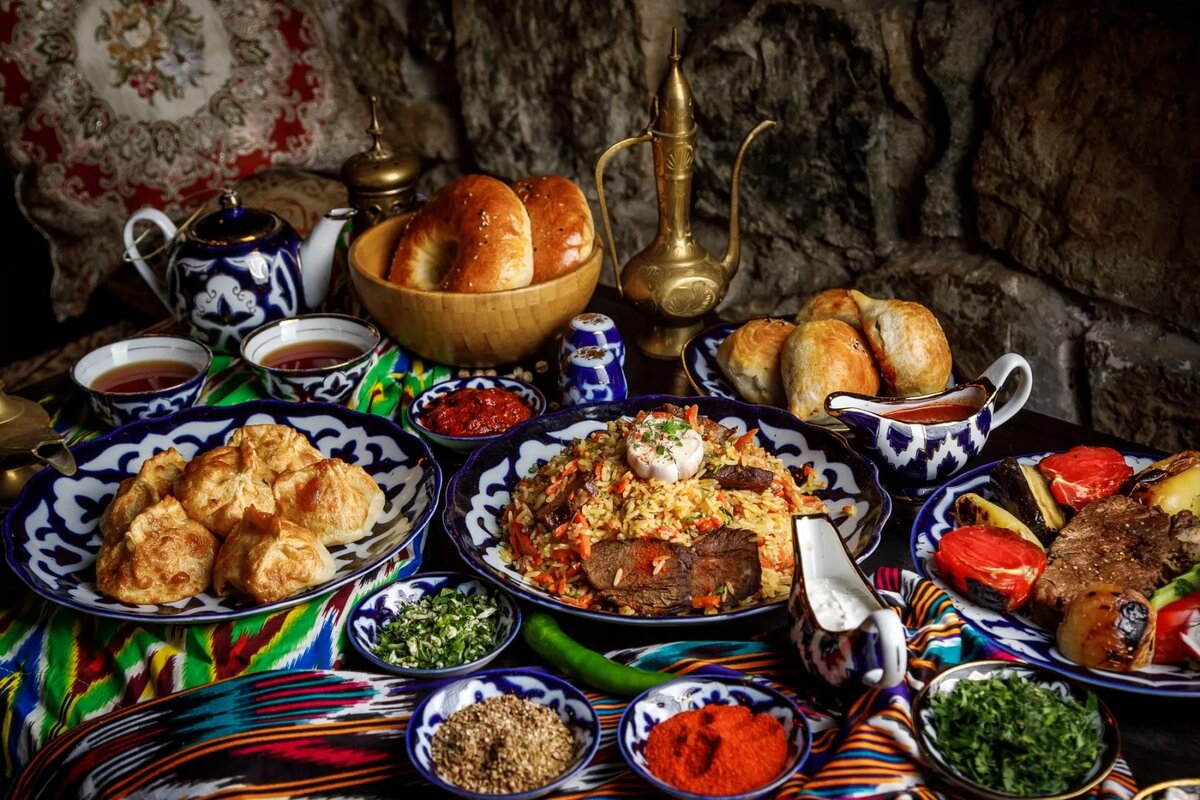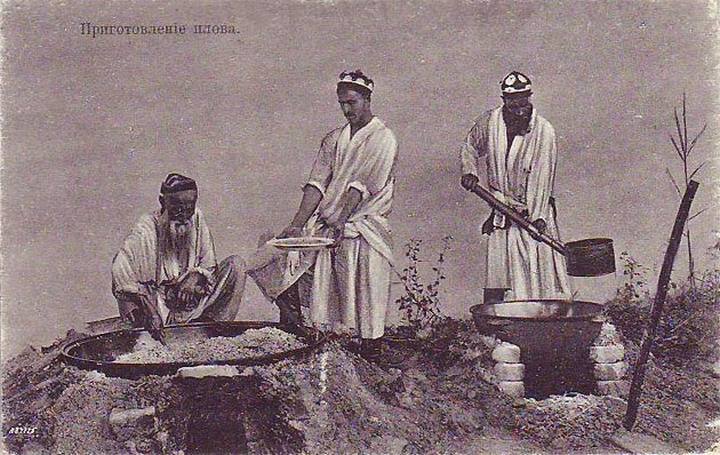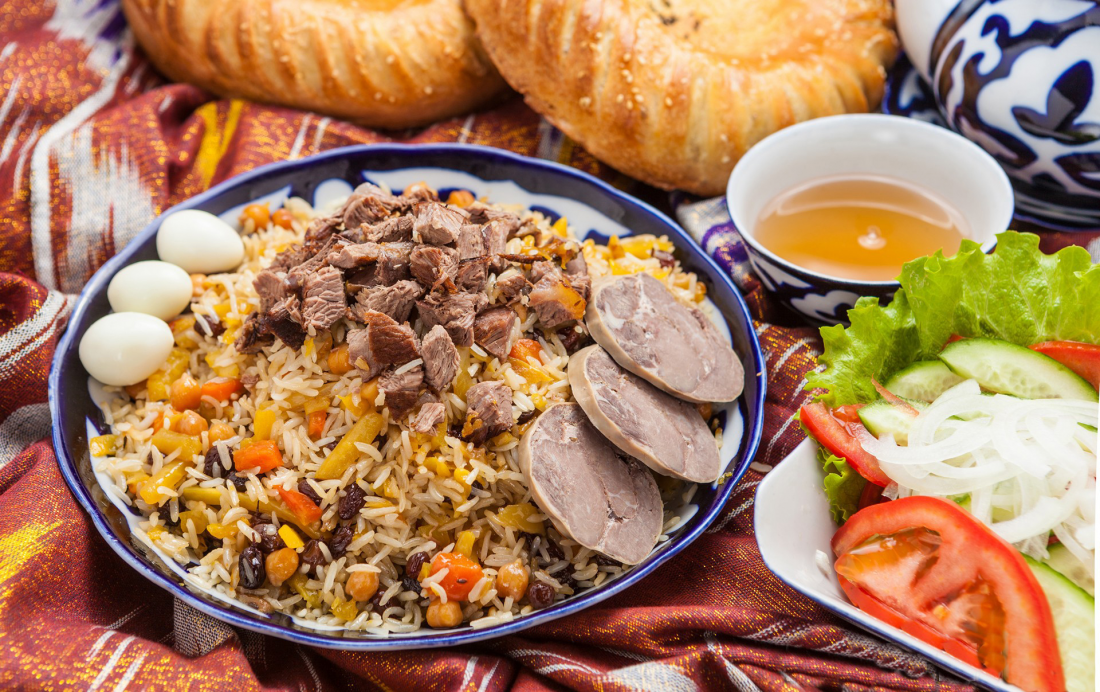Uzbek pilaf in the XIX century
Uzbek pilaf is a real brand of the most delicious rice and meat dish.

The dish was prepared everywhere in big cities, villages, mountain villages, among the settled population and nomads. This dish has long had several cooking recipes, which we will share with you below. To prepare pilaf, first, mutton broth was cooked in a large cauldron. Then the broth was poured into a bowl, onions, boiled lamb and carrots were fried in fat. After frying the ingredients, rice was added to the cauldron, which languished until it was ready. To serve, pilaf was put on the drum, and lamb cut into small bars on top of it. It was customary to eat pilaf with your hands, licking your fingers, because they had not used table tools before, but this made the pilaf even tastier. The shurpa was drunk directly from the spit.  Another way of cooking pilaf was as follows. They took a lamb dumpling, cut it into small pieces and cooked it in a cauldron over high heat. After the pork rinds were taken out of the boiler, and the oak was salted. Red pepper and chopped onion were also added to the pot. When everything was fried together, the lamb cut into small pieces was put in the cauldron. After a little roasting of the meat, carrots, quince, pitted raisins, dried or fresh apricots were added to the cauldron, but it was rather optional. Then rice was poured on top, previously well washed in cold water and scalded with boiling water. Boiling water was poured into the rice until the oil and water rose about one finger above the cereal. Then the dish was cooked over high heat, and when the rice had absorbed all the water, the fire was reduced and the cauldron was covered with a lid. Some preferred to eat pilaf with radish and kaymak. Sometimes the dish was watered with apple cider vinegar, pomegranate juice or other sour tinctures.
Another way of cooking pilaf was as follows. They took a lamb dumpling, cut it into small pieces and cooked it in a cauldron over high heat. After the pork rinds were taken out of the boiler, and the oak was salted. Red pepper and chopped onion were also added to the pot. When everything was fried together, the lamb cut into small pieces was put in the cauldron. After a little roasting of the meat, carrots, quince, pitted raisins, dried or fresh apricots were added to the cauldron, but it was rather optional. Then rice was poured on top, previously well washed in cold water and scalded with boiling water. Boiling water was poured into the rice until the oil and water rose about one finger above the cereal. Then the dish was cooked over high heat, and when the rice had absorbed all the water, the fire was reduced and the cauldron was covered with a lid. Some preferred to eat pilaf with radish and kaymak. Sometimes the dish was watered with apple cider vinegar, pomegranate juice or other sour tinctures.

The peasants cooked pilaf with vegetable oil, less often with sesame oil, and the meat was used pre-cooked for shurpa. The rich could cook pilaf much more often, sometimes they cooked it with stuffed quails and it turned out "Bedana palov", which is very tasty.
Another kind of pilaf "Kavatok palov" is pilaf with cabbage rolls made of grape leaves. For such a dish, lamb and onion were chopped finely, black or capsicum and fragrant grass were added. Then minced meat with onions and spices was put into the young grape leaves, carefully folded and tied with a thread, and all this culinary miracle was laid out on top of the cooking pilaf. Usually Kavatok palov was prepared in early spring, as soon as the first leaves of the vine appeared.Mutton was mainly used for cooking pilaf, but other types of meat and even game were also consumed. Nomads mostly cooked pilaf without onions, carrots and spices, but added more meat.

The Russian scientist B.P. Kushelevsky, traveling in the Ferghana region, wrote in 1891: "Pilaf is readily consumed by Russians living in Ferghana, especially when hunting, traveling and at various native festivals. This dish is very tasty, nutritious, and at the same time not burdensome for the stomach, despite the fact that it is very fatty. It is considered indecent to refuse the offered pilaf, and therefore an Uzbek, having visited several houses, will sometimes eat it as many times without feeling burdened."
Leave a comment
By logging in, you agree to the processing personal data
See also
Workhours: 9:00-18:00, Mn-Fr
For any questions
Uzbekistan


 UZB
UZB RUS
RUS JPN
JPN ARA
ARA FRA
FRA CN
CN DE
DE POR
POR ESP
ESP TUR
TUR ITA
ITA HIN
HIN MAL
MAL





A comment